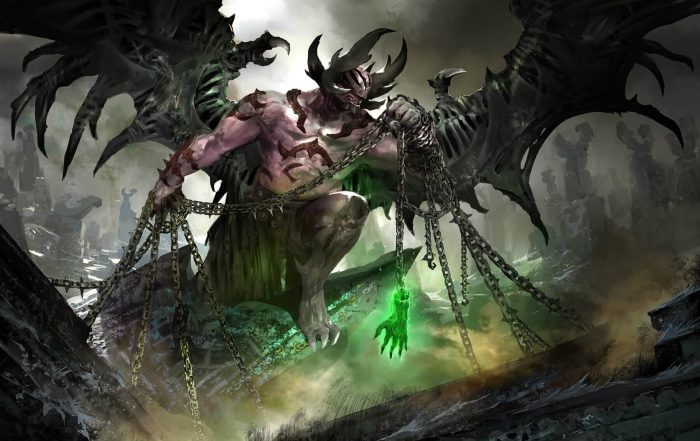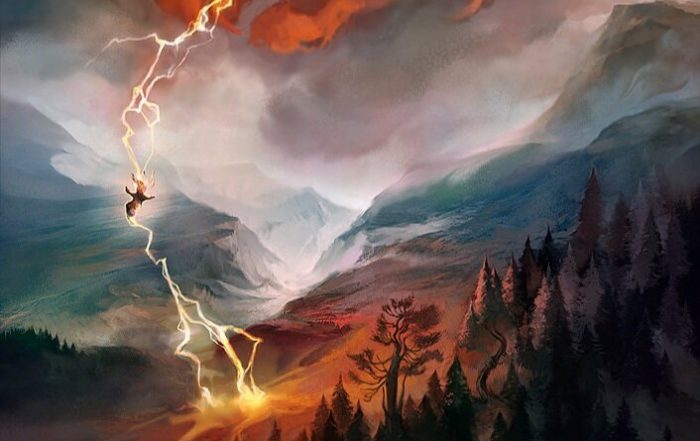Un-Limited Insights – Innistrad: Midnight Hunt
Innistrad Midnight Hunt in Limited
First Impressions
Author: Nico Bohny (Translated and edited from German by Thomas Preyer)
Friends of the Sun and the Moon get ready. It is time to pack your bags and travel back to Innistrad. For me, it feels like sort of a childhood family holiday – big expectations, nostalgic feelings to see familiar places again and to explore them and see them in a new way.
Lately, Wizards is doing some really nice holiday advertisements for their new sets as well. Check out the following video about the wonders of Innistrad. Makes you want to book a trip immediately, right?
Klicken Sie auf den unteren Button, um den Inhalt von cdn.embedly.com zu laden.
In addition to the lovely Halloween vibes the set is giving me, it also has a lot of variety to offer. Especially compared to MTG’s most recent expansion, Adventures in the Forgotten Realms, or the cash-grabbing Modern Horizons 2 – which was out there to drive us into financial ruin.
As an avid Spider Spawning lover, I do have scary, in a good way, feelings regarding Innistrad Limited – and quite naturally, high expectations for this one.
The First 10 Drafts
So far, 10 drafts into the format, my expectations have been fulfilled. Innistrad brings to the table what other recent sets lacked – a draft format that favors synergy over individual card power. Hence, a steady stream of new decisions and experiences occur during a draft.
Often limited formats make it easy to compile a list of top commons within no time. Regarding Innistrad, this cannot be more untrue. The value of each card has to be seen in relation to previous and future picks and the deck’s curve.
This makes drafting the format really exciting. A couple of examples: Vampire Interloper might be the best black Common for some decks, but the worst for others. Organ Hoarder has boarded the hype train for best common, but there are endless situations where one would want a cheaper or more synergetic card instead.
Removal spells are always top contenders for high picks, but they don’t really help any of your strategies, therefore you will be forced from time to time to pick key cards over them.
I will not give you card rankings today, but rather I wanted to show you what kind of avenues and archetypes are viable and how to get to the best versions of them. If one can even say that after about 10 drafts.
The Speed Of The Format
One of the earliest questions that arise in a new format: How fast is it? The answer usually influences the decision on how high slower cards have to be picked and how high life-saving two-drops should be on your priority list.
So far the format seems not to fast. I would give it a seven from ten possible quickness points.
Numerous cards will give you card advantage in the late game, mostly due to Flashback and Disturb. On top of that, there are a lot of creatures who have great come into play abilities, even a bunch of them give you an extra card.
Don’t get me wrong, there are fast decks in the format, but the above-mentioned abundance of card advantage spells, a lot of them are creatures, means that the playing field won’t be unoccupied, as it would be if you would cast a spell like Divination instead of Organ Hoarder, Baithook Angler, Shadowbeast Sighting or Eccentric Farmer. Those spells are obviously more effective against aggressive decks than pure card draw.
The Best coloUrs
My first impressions are in line with most others: Black, Blue, and White are the best colors in Innistrad Limited. But that doesn’t mean that other combinations can’t be equally as strong or stronger if open on your table.
The Esper colors are immensely deep on a common level. If you look for fillers, you would have a hard time finding them. Therefore, those colors support multiple players drafting them without significantly weakening the overall deck quality.
On top of that, some of the strongest Uncommons (Morbid Opportunist, Borrowed Time, Infernal Grasp) can be found in Esper.
Archetype Overview
UB Zombies
Common sense tells us that this is the strongest deck. Crawl from the Cellar, Bladestitched Skaab, and Champion of the Perished will make you think this is a tribal deck, but in its best form, this is a deck full of synergy between sacrifice and token effects.
Getting tokes is easy with all those decayed tokens that get spit out by well-known cards from the past like Mind Rot, Repel, or Convolute.
The challenge seems to be achieving a good balance between enablers and payoffs, but in my opinion, both types are strong in the set and can therefore exist with even a small amount of the other.
Naturally generated card advantage is everywhere, which makes early plays more important. They will help to not get overrun by the more aggressive decks. I tend to play 18 lands in these decks, as there are cards that let me sink my mana late in the game, but being short on resources early in the game often spells doom.
An interesting side note is, that the archetype is often quite tempo-oriented with cards like Falcon Abomination, Ecstatic Awakener, and Siege Zombie, but can be excellent at grinding out long games with cards like Organ Hoarder, Crawl from the Cellar and the many removal spells available as well.
UW Disturb
The core of the deck plays like a traditional flyer deck. Blockers on the ground and flying in for the win. Disturbed gives you a great lategame and therefore card draw is not as important as it usually is for blue midrange decks.
Even without spectacular picks, a solid option, but good rares, and the number of Shipwreck Sifters you can get your hands on, can push it over the top.
Luckily, those “powerful” Sifters are pretty useless in other archetypes, but very good in UW. They give us a good two-drop, card advantage, and synergy. And they get better in multiples. Sure, you need good amounts of Disturb creatures, to make this work. Lastly, Lunarch Veteran is one of the top cards in the archetype.
BW Tokens
A big plus of this deck type is that it makes it super hard for your opponent to interact with it. Especially cards like Search Party Captain, Rite of Oblivion, Morbid Opportunist, and Ritual of Hope can’t be easily handled or played around.
The deck gets more aggressive if its focus is more on white cards. Furthermore, black decayed cards and Ecstatic Awakener shine in BW Tokens, which is the archetype that in my opinion utilizes zombie tokes aggressively best. Not the least due to the powers of Ritual of Hope.
Green Ramp Decks
Classic midrange decks who eventually win in the lategame with value generated from graveyard spells, usually flashback cards. This archetype likes to put Path to the Festival and Dawnhart Rejuvenator to work, which makes splashing for bombs easier than for other archetypes.
Eccentric Farmer is excellent for this deck. They bring a land, a body, and sometimes mill flashback cards. That’s a lot of value for just three mana. The card also fixes a problem self mill decks usually have: Milling the splash land away.
Rise of the Ants, Dryad’s Revival, and Brood Weaver are all great in these kinds of decks. So much for the green core.
A secondary color should help us survive the early game, namely through bringing two casting cost spells to the table. Why? Green already has decent commons with Farmer, Rejuvenator, Path, and Shadowbeast Sighting later in the curve, but lacks premium two mana plays.
White isn’t really made for ramp. Blue and Red have fantastic Uncommons (Obsessive Astronomer, Cathartic Pyre, Rootcoil Creeper) and Black has Olivia’s Midnight Ambush, a solid and more importantly cheap common removal.
Frankly, most of the time, Rares will lead the way and dictate which secondary or even tertiary color your deck will add. Without any bombs to splash, you really don’t have much incentive to add a third color anyway.
RG Werewolves
This could be subsumed in the green midrange category with ramp elements. Red has a couple of cheap removal and Rise of the Ants and Ramp work well too. Nonetheless, I tend to think that the best red/green deck is a Werewolf based deck.
On a sour note I have to disclaim that Werewolves have a tough time with Defenestrates, Olivia’s Midnight Ambushes and Silver Bolts flying around everywhere.
A perfect Werewolf-curve looks like this. Turn 2 to 5 brings a werewolf, then wait for the night to come and have instant removal ready at the end of your opponent’s turn.
Lunar Frenzy is simply fantastic and gets picked by me over all other Commons and Uncommons, if a healthy amount of werewolves can be provided.
UG Flashback
The two multicolor Uncommons lead in two different directions. Aggressive and tempo-focused – Winterthorn Blessing. Ramp and lategame – Rootcoil Creeper.
Both versions of the deck are frankly just weaker than their green/white or green/black cousins.
Green gives you most of the ramp and expensive lategame cards, and the secondary color should help stabilize the early game. And black, with its removal, is just plain better than blue with its value and card advantage cards.
On the other hand, an aggressive strategy is better supported by white than blue.
Sure, if both colors, green and blue, are underdrafted at your table, a great deck can happen. But I wouldn’t want to force it.
The Rest
I can’t say much about the following archetypes yet, because I either haven’t drafted them myself or haven’t even played against them a lot.
- GW Tokens should be good, having a straightforward plan dictated by Dawnhart Wardens and Join the Dance.
- BG is a ramp deck, and Morbid (Grizzly Ghoul & Diregraf Rebirth) should only be an afterthought.
- UR Spells looks super intriguing, but I haven’t seen it work yet in person.
- RB Vampires I have tried, but I have failed to get a sufficient creature count. It was just a lot of removal, which is fine, but not a great deck with synergies.
Conclusion
These are my first impressions of the format. I hope you had a good time so far as well and get to enjoy the time of hollow pumpkins and scary tales way before Halloween as much as I do.
About the Author
Nico Bohny is a retired Pro Player from Switzerland. His impressive resume contains of two PT top 8’s, 2 Grand Prix Top 8’s and a win with the Swiss national team at Worlds 2007, where they beat Austria in the finals. He’s a Vintage aficionado and skilled Limited player.

All Articles by Nico Bohny
Inside an Old Wizards Peaceful Mind
Pro player Nico Bohny writes about how his relation to MTG changed over different periods of his life. From world traveling MTG champion to family all-star! Here you can read all about his very personal "work, life and Magic" balance.
Un-Limited Insights – Innistrad: Midnight Hunt
Our favorite Swiss Nico Bohny is traveling to Innistrad. He shares his first impressions from Midnight Hunt draft and has some really valuable tips for us.
The First Decision – Play or Draw in Draft and Sealed
Nico Bohny is covering a question Magic the Gathering Limited Players have been asking themselves since forever: Play or Draw? He will help you come up with an informed decision in both Booster Draft and Sealed Deck play.













